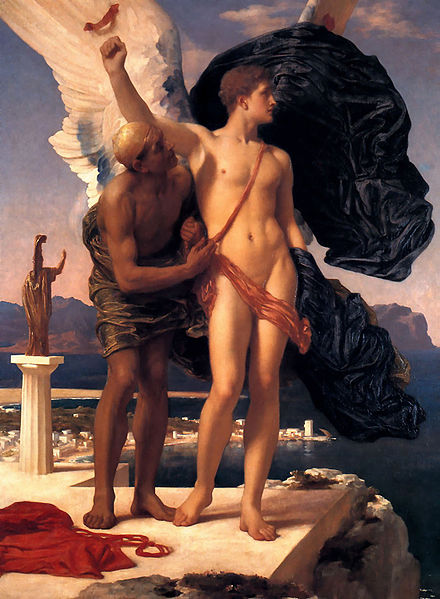Daedalus Inventor
By Peter LloydKnown in Greek mythology as a skillful craftsman and artisan, Daedalus was an innovator and inventor. He gets credit for the invention of carpentry and with that the invention of the axe, plumb-line, drill, glue, and isinglass. Mythological credit, that is.
So what if Daedalus is a myth. He's Greek and bears gifts. Here are just a few lessons about creativity, invention, and innovation we can learn from the myth whose son, Icarus, flew too close to the sun.
 Mistakes
MistakesDaedalus seems to have accepted the idea of making mistakes and accepting mistakes as lessons. The great craftsman erred when he created a labyrinth so complex that even he almost got lost in it. But someone else found a way in and out by simply laying down string on the way in and following the string back out. Apparently Daedalus had not considered this simple solution.
Most heartbreaking, of course, was the loss of his son, Icarus. Daedalus fashioned wings made of feathers held together in part with wax. Although he warned his son not to fly too close to the sun, the boy flew too high, the wax in his wings melted, and Icarus perished in the sea.
How important to consider the long-term consequences of our inventions and prevent them from doing more harm than good.
Biomimicry
Daedalus trained a nephew in his new art of carpentry. Walking along the seashore one day, the nephew spied a fish skeleton and came up with an idea and notched a piece of iron to create a saw. He also designed a compass inspired by the skeleton. Could this be the earliest example of biomimicry?
Not Invented Here
Beware, we are told, of Greeks bearing gifts, thanks to the Trojan Horse. Daedalus may have been the first example of the Not Invented Here syndrome. So jealous of his nephew's skills and so afraid that someone else might better him, Daedalus took extreme measures. He threw his nephew off a cliff.
Inspiration
Flawed as he might have been, Daedalus still inspires. The British Interplanetary Society proposed the idea of an unmanned spacecraft using current or near-future technology that could reach any of a number of target stars within a human lifetime. They named it Project Daedalus.
Daedalus has inspired the arts to point of symbolizing the romantic artist—rebellious, impetuous, and one who defies convention even to the point of self-destruction. In Portrait of the Artist as a Young Man, James Joyce's protagonist, Stephen Dedalus, paints his future artist self as “a winged form flying above the waves...a hawk-like man flying sunward above the sea, a prophecy of the end he had been born to serve.”
Thanks, Greece!
No one should doubt the universal influence of the Greeks and Greek thinking and innovation. Alfred Whitehead has gone so far as to write, “The safest general characterization of the European philosophical tradition is that it consists of a series of footnotes to Plato.” In that spirit of gratitude, thanks to Daedalus Inventor!
Peter Lloyd is co-creator with Stephen Grossman of Animal Crackers, the breakthrough problem-solving tool designed to crack your toughest problems.
Right Brain Workouts Explained
